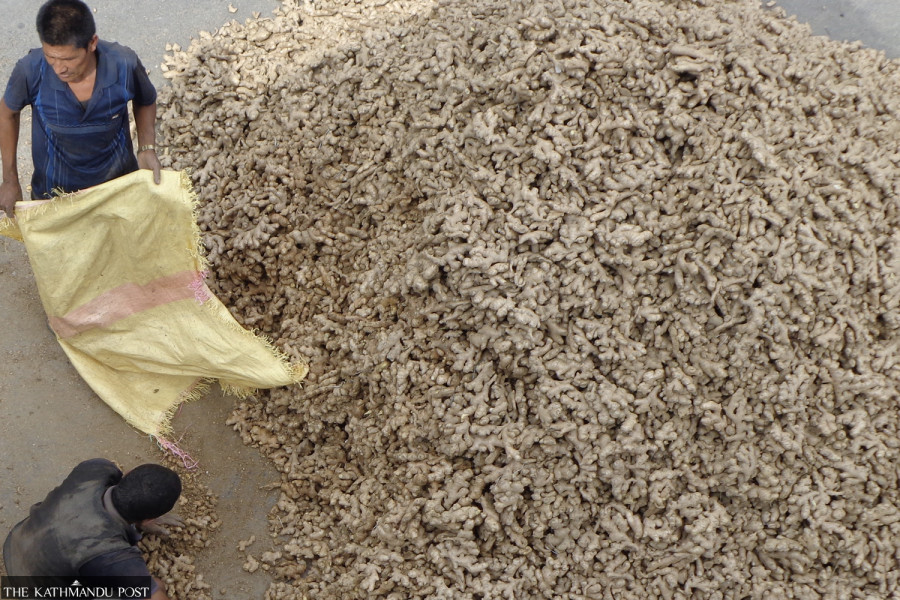Money
Nepal’s high-value exports see modest growth amid surge in edible oil shipments
Of the country’s total export earnings of Rs217.91 billion, goods listed under the NTIS earned Rs83.10 billion in export revenue in the first ten months.
Post Report
Nepal’s export earnings from high-value products increased by 6.74 percent in the first ten months of the current fiscal year, driven by shipments of yarn, jute and jute products, felt, tea, dog chew, and fabrics.
According to the latest data from the Trade and Export Promotion Centre and the Department of Customs, goods listed under the Nepal Trade Integrated Strategy (NTIS) generated Rs83.10 billion in export revenue between mid-July 2024 and mid-May 2025.
This accounts for a significant portion of the country’s total export earnings of Rs217.91 billion during the same period.
While high-value products saw only modest growth, Nepal’s total exports surged by 72.71 percent, mainly due to a dramatic increase in the export of refined edible oils such as soyabean, sunflower, and palm oil. These oils are not produced commercially in Nepal but have become a major re-export commodity due to duty-free access under the South Asia Free Trade Area (SAFTA).
In the first ten months, Nepal exported 430,504 tonnes of these refined oils worth Rs 90.75 billion. The export boom was triggered by an earlier hike in India’s customs duty on crude edible oils to 20 percent, which made Nepal's refined oil exports more competitive in the Indian market.
However, India’s recent move on May 30 to reduce its customs duty on crude edible oils to 10 percent could slow down Nepal’s soaring exports.
Trade experts warn that the emphasis on re-exports like edible oil masks the sluggish performance of Nepal’s genuine high-value exports.
Former trade secretary and expert Rabi Shankar Sainju said political interference and poor inter-ministerial coordination are key reasons for the NTIS's weak implementation.
“The ministries have started working more in favour of political parties than for economic growth. The Board of Trade, too, has become a formality, failing to boost trade meaningfully,” he added.
Despite systemic challenges, some NTIS-identified high-value products showed encouraging trends.
Yarn exports rose by 20.7 percent to Rs 11.65 billion, contributing 6.35 percent to Nepal’s total exports. Carpet exports increased slightly to Rs 8.84 billion, up from Rs 8.79 billion last year, contributing 4.06 percent of total exports.
Jute and jute product exports grew by 15.5 percent to Rs 6.92 billion, while felt products saw a 6.3 percent increase to Rs 4.09 billion. Tea exports increased by 37 percent, reaching Rs 3.97 billion on 14,030 tonnes.
Dog chew exports rose 33.7 percent to Rs 3.49 billion, fabric exports were up 21.9 percent to Rs 2.51 billion, and pashmina exports increased by 5.4 percent to Rs 2.49 billion.
Thanks to India’s recent facilitation in renewing the Bureau of Indian Standards (BIS) certificates—previously a barrier to trade—cement and footwear exports rebounded. Cement exports grew by 6 percent to Rs 1.76 billion, while footwear exports soared by 43.5 percent to Rs 1.50 billion.
The rosin and resin acid shipment jumped by 55.9 percent to Rs 1.70 billion, with 11,523 tonnes exported. Handmade paper exports climbed 14.2 percent to Rs 999.54 million, while silver jewellery increased by 1.7 percent to Rs 135.18 million.
Spice exports increased by 4.8 percent to Rs 609.18 million on a volume of 4,444 tonnes. Pasta exports grew 11.5 percent to Rs 1.82 billion from 7,154 tonnes. Honey exports experienced a dramatic jump of 196.7 percent to Rs 48.57 million, although the quantity was a modest 7 tonnes.
Despite gains in select sectors, several of Nepal’s traditional exports experienced notable declines.
Iron and steel exports, one of the top earners, dropped 1.6 percent to Rs 13.84 billion, contributing 5.35 percent to total exports. Readymade garments fell by 5.7 percent to Rs 6.97 billion, with 12.88 million pieces shipped.
Large cardamom exports decreased by 3.6 percent to Rs6.67 billion, based on a volume of 3,686 tonnes. Ginger exports plunged 50.9 percent to Rs 526.58 million, with 3,161 tonnes shipped.
Medicinal herb exports declined 14.6 percent to Rs 1.60 billion, while essential oil exports dropped 17.8 percent to Rs 429.66 million from 31 tonnes. Lentil exports fell by 37.7 percent to Rs 241.32 million on a volume of 1,676 tonnes.
Gold jewellery exports dipped by 4.2 percent to Rs 34.96 million.
Vegetable exports contracted by 18.1 percent to Rs 145.79 million, with 8,129 tonnes sent primarily to India, Hong Kong, Qatar, the UAE, and Japan.
Exported vegetables included tomatoes, garlic, Brussels sprouts, cabbage, beetroot, radish, peas, asparagus, mushrooms, capsicum, pumpkin, squash, and gourds.
Fruit exports fell sharply by 28.6 percent to Rs 6.11 million, with just 216 tonnes shipped. Coffee exports also dropped by 49.1 percent to Rs 46.97 million, with 43 tonnes exported.
The overall picture of Nepal’s exports remains mixed. While NTIS-prioritised goods have shown some progress, their growth is dwarfed by the re-export of edible oils, raising concerns about the sustainability and structure of Nepal’s export economy.
Experts argue that long-term growth will depend on consistent policy implementation, institutional reforms, and better coordination across government agencies. “Nepal’s trade policy needs to break out of its ritualistic habits and start functioning with the clear goal of boosting production and exports of genuinely domestic products,” Sainju said.
As India adjusts its import duties and global market dynamics shift, Nepal’s reliance on re-export schemes like edible oils may soon face headwinds. Experts say that a stronger focus on building export capacity in high-value sectors identified by the NTIS could offer more sustainable paths to trade growth and economic resilience.




 15.12°C Kathmandu
15.12°C Kathmandu














